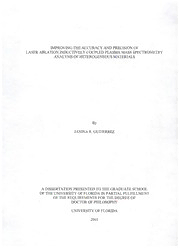
Improving the accuracy and precision of Laser Ablation Inductively Coupled Plasma Mass Spectrometry analysis of heterogeneous materials PDF
Preview Improving the accuracy and precision of Laser Ablation Inductively Coupled Plasma Mass Spectrometry analysis of heterogeneous materials
IMPROVINGTHEACCURACYANDPRECISIONOF LASERABLATIONINDUCTIVELYCOUPLEDPLASMAMASSSPECTROMETRY ANALYSISOFHETEROGENEOUSMATERIALS By JANINAR.GUTIERREZ ADISSERTATIONPRESENTEDTOTHEGRADUATESCHOOL OFTHEUNIVERSITYOFFLORIDAINPARTIALFULFILLMENT OFTHEREQUIREMENTSFORTHEDEGREEOF DOCTOROFPHILOSOPHY UNIVERSITYOFFLORIDA 2003 Thisdocumentisdedicatedtomyparents,GirmeandCarmencita;andtoRod. ACKNOWLEDGMENTS IthascertainlybeenaprivilegetoworkundertheguidanceofDr.JamesD. Winefordner. Ithankhimnotonlyforsharinghiswisdomandknowledgeinscience withme,andmoreforbeingakindandunderstandingadviser. IespeciallythankDr. BenjaminSmithforgivingmeguidanceanddirectioninmyresearchandmorefor alwaysbeingreadytolisten. IthankDr.NicoloOmenettoforhisencouragementand supportinallmyscientificendeavorsbutmore forhiscontagiouspositiveoutlookin life. Heneverfailedtoletmeseethepositivesideineverything. IthankDr.WilliamW.Harrisonfortheencouragementandmanyhelpful discussionsingroupmeetings.IalsothankDr.IgorGorunshkinforthemanyhelpful discussionsonresearchandlife. IthankDr.PaulMuellerforthemanyin-depth discussionsaboutthefieldofLaserAblationICPMS. Ithankmycommitteemembers, Dr.DavePowellandDr.JohnEylerfortheirsupport. IalsothankDr.DavidHahnfor thecountlesshelpfuldiscussionsonlightscattering,andfortheuseoftheparticle measuringsystems. IthanktheERC,especiallyDr.KevinPowersandGilBrubaker,for generouslylettingmeusetheAerosizer. IthankthePacificNorthwestNational Laboratory,particularlyDr.MichaelAlexander,forfundingtheresearchandforloaning metheArgon-ionlaserandthewastesimulantsamples. IthanktheentireWinefordnergroupfortheirsupport.IthankespeciallyXihong Wufortakingthetimetohelpmewithotherpeople’ssamplessothatIcouldconcentrate onmywork. iii IespeciallythankJamshidTemirovforalwaysbeingreadytohelpwithanythingin thelaboratory;withlasers,plumbing,lifting,andevenwithcoffee.He,alongwithFiruza andDiyora,hasbeen,morethananything,myfamilyinGainesville;andnowordscan fullyexpressmyloveandgratitudeforthem. Ideeplyexpressmygratitudetomy friends,IsaBenitez,IvanaBoridarivic,andTamaraBlagojevic,whohavestoodwithme fromthefirstdayofgraduateschooltothelast. Iwouldnothavesurvivedlifein graduateschoolwithoutthem. IwouldalsoliketothankRovelynTapec,CelesteRegino, CamillaYandocandGinoAbiesforwelcomingmeintoGainesville. Theyhelpedmake Gainesvilleasecondhomeforme. Ithankmyfamilyfortheirsupportandencouragement;especiallymyparents GirmeandCarmencita. Ifeeltrulyblessedtobelovedbysomanypeople.Lastly,I wouldliketothankmyfiance,Rod,whohasalwaysstoodbymenomatterwhat.Ithank himforhislove,support,andespeciallyhispatience.Hehasgivenmesomethingtolook forwardtoeveryday. Iconsidermyselfaveryblessedperson. iv TABLEOFCONTENTS Page ACKNOWLEDGMENTS iii ABSTRACT viii CHAPTER 1 INTRODUCTION 1 2 BACKGROUND 5 FundamentalsofLasers 5 PropertiesofLaserRadiation 5 PrinciplesofLaser 6 TemporalModes 9 Nd:YAGLasers 10 PrinciplesofLaserAblation 10 LaserAblationProcess 10 Laser-solidInteraction 12 InductivelyCoupledPlasmaMassSpectrometry 13 InductivelyCoupledPlasmas 14 TheIonizationProcess 18 InterfacingICPandMassSpectrometer 20 QuadrupoleMassSpectrometer 25 MassDetectors 27 SampleIntroduction 30 LaserAblationInductivelyCoupledPlasmaMassSpectrometry 30 AnalyticalEfficiency 34 AblationEfficiency 34 TransportEfficiency 34 IonizationEfficiency 35 QuantitationStrategies 35 NuclearWasteSamples 36 3 SOURCESOFNOISEINTHELA-ICPMS 41 Background 41 ExperimentalMethods 42 Results 44 Conclusion 50 v 1111 4 PARTICLESIZEDISTRIBUTIONSTUDIESOFLASERABLATEDMATERIAL5 Background 51 ExperimentalMethods 53 Results 55 EffectofLaserWavelength 55 EffectofLaserIrradiance 62 EffectofSampleMatrixProperties 65 Conclusion 70 5 USINGANINERTIALIMPACTORTOIMPROVEPARTICLESIZE DISTRIBUTIONOFLASER-ABLATEDMATERIAL 71 Background 71 ExperimentalMethods 77 Results 79 EffectivenessoftheInertialImpactorasaParticleFilter 79 EffectonSignalIntensityandPrecision 83 EffectonFractionation 88 Conclusion 88 6 NORMALIZATIONOFLA-ICPMSSIGNALTOLIGHTSCATTERED BYLASER-ABLATEDMATERIAL 91 Background 91 PrinciplesofParticleScatter 92 TheoreticalConsiderationstoNormalizationofICPMSSignalwithLight Scatter 94 ExperimentalMethods 104 Results 11 FundamentalStudies 11 Lightscatterasafunctionofparticlediameter 11 Lightscatterasafunctionofparticlenumberdensity 118 ScatterofAblatedMaterial 121 Normalization 124 Conclusion 132 7 NORMALIZATIONWITHSPECTRALEMISSIONINTENSITY FROMTHELASERINDUCEDPLASMA 134 Background 134 ExperimentalMethods 135 Results 136 Conclusion 147 8 LA-ICPMSANALYSISOFWASTESIMULANTS 148 ExperimentalMethods 148 Results 149 Dryvs.WetAblation 149 vi LA-ICPMSAnalysisofWasteSimulant 153 StudiesPerformedwiththePNNLSystem 164 Effectofvaryinglaserirradiance 164 Rastervs.noraster 171 Impactorstudies 171 Scanningelectronimages 175 Conclusion 181 9 CONCLUSIONANDFUTUREWORK 182 Conclusion 182 FutureWork 184 LISTOFREFERENCES 186 BIOGRAPHICALSKETCH 189 vii AbstractofDissertationPresentedtotheGraduateSchooloftheUniversityofFloridain PartialFulfillmentoftheRequirementsfortheDegreeof DoctorofPhilosophy IMPROVINGTHEACCURACYANDPRECISIONOFLASERABLATION INDUCTIVELYCOUPLEDPLASMAMASSSPECTROMETRYANALYSISOF HETEROGENEOUSSAMPLES By JaninaR.Gutierrez August2003 Chair:JamesD.Winefordner MajorDepartment:Chemistry Laserablationinductivelycoupledplasmamassspectrometry(LA-ICPMS)has developedintoanimportantandindispensabletoolforsolidsamplinganalysis.Theuse ofLA-ICPMSallowsrapidinsituanalysisrequiringminimalsamplepreparationwhile usingaminimal amount(micrograms)ofsample. Lowdetectionlimitsofpartsper billionarealsoeasilyachievedformostelementsusingtheLA-ICPMS. However,the useofLA-ICPMShasyettobefullydevelopedasarapidandroutinemethodofanalysis forheterogeneousmaterials. Matrix-matchedstandards arerequiredforquantitative analyses. Variations in the laser ablation process, and elemental and isotopic fractionationsmayoccurduringanalysisaffectingbothprecisionandaccuracy. ThegoalofthisresearchistoimprovetheprecisionandaccuracyofLA-ICPMS analysisofheterogeneousmaterials. viii Initialstagesofthestudyinvolvedfundamentalstudiestodeterminethecausesof poorprecisionandaccuracyinLA-ICPMS. Resultsshowedthatthelimitingsourceof noiseinLA-ICPMSisflickerorexcesslowfrequencynoiseoriginatingfromvariations inthesampleaerosolastheyarecreated,transportedandintroducedintotheICP.Particle sizedistributionstudiesoflaser-ablatedmaterialwerethenperformedtodeterminethe ablation parameters that produced sample aerosol with the optimum particle size distributionyieldingthebestICPsignalintermsofsignalintensityandstability. Aninertialimpactorwasusedtoimprovetheparticlesizedistributionofthe ablatedmaterialpriortoitsintroductionintotheICPMS.Resultsshowedthatremoving thelargerparticlesfromablatedmaterialimprovedICPMSsignalprecision. ICP-induced elemental and isotopic fractionation effects were also reduced by removing larger particlesfromtheablatedmaterial. Lightscatteredbyablatedmaterialwasalsocollected andusedfornormalizationoftheICPMSsignal. Resultsshowthatnormalizationtolight scatteredbytheablatedmaterialcompensatedforvariationsinthemassablated,orthe numberofparticlesablatedduringananalysis. Theuseofthespectralemissionintensity ofananalytecollectedfromthelaser-inducedplasmatonormalizeitscorrespondingLA- ICPMSsignalwasalsoinvestigated. Finally,theproposedapproachestoimprovingtheprecisionandaccuracyofLA- ICPMSwereappliedtoheterogeneousnuclearwastesimulants. IX CHAPTER 1 INTRODUCTION LaserAblationInductivelyCoupledPlasmaMassSpectrometry(LA-ICPMS)has developedintoanimportantanalyticaltoolinavarietyofapplicationsinvolvingawide rangeofsolidmaterialssuchasglasses,ceramics,soils,andplastics’. TheuseofLA- ICPMSallowssolidsamplingofdiversematerialsrangingfromconductingtonon- conducting,andfromorganictoinorganicmaterials.Solidsintheformofsheets, powders,pastesandevensludgescaneasilybesampled. TheuseofLA-ICPMSallows rapidinsituanalysisrequiringminimalsamplepreparationwhileusingaminimal amount(micrograms)ofsample. Lowdetectionlimitsofpartsperbillionarealsoeasily achievedformostelementsusingtheLA-ICPMS. However,theuseofLA-ICPMShas yettobefullydevelopedasarapidandroutinemethodofanalysis.Matrix-matched standardsarerequiredforquantitativeanalyses. Variationsinthelaserablationprocess andelementalandisotopicfractionationsmayoccurduringanalysisaffectingboth precisionandaccuracy.TheuseofLA-ICPMSlacksbothprecisionandaccuracy. Current%RSDsrangefrom5to20%dependingonthesamplebeinganalyzed.13 Theseproblemsareescalatedintheanalysisofheterogeneoussamples. Heterogeneityisdefinedinthisresearchastheexistenceofnon-uniformityofaphysical orchemicalpropertyinthesample. Theheterogeneoussampleswerefertopossessnon- uniformityinsamplesurfacemorphologyandconsistency;andnon-uniformityinsample composition,specificallynuclearwastes. Nuclearwastesconsideredinthisstudyarein theformofsludge,andpaste,seeminglyhighlyviscousliquidswithsolidgranules 1
